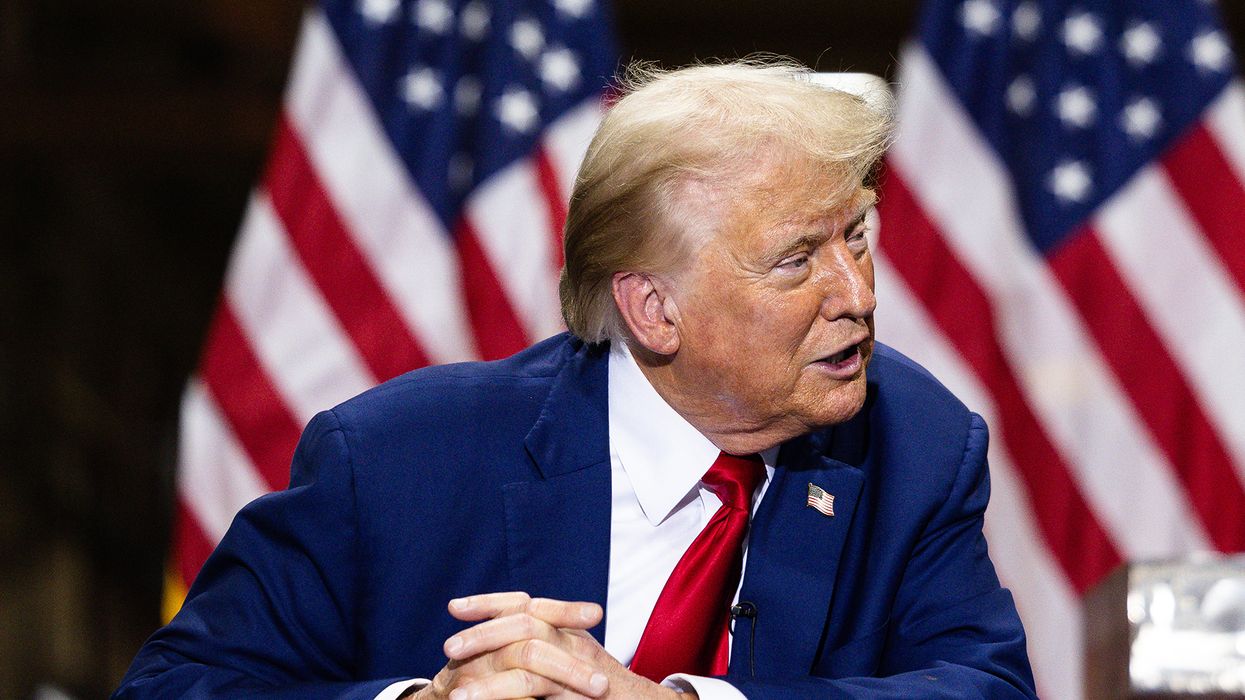ODESA, Ukraine — The American Century is ending, with external adversaries outmaneuvering the United States in critical strategic contests worldwide, while internal extremists destroy American leadership.
Whether one believes — as American officials say they do — that the purpose of U.S. power is to enforce a “rules-based” liberal international order and defend human rights, or whether one believes — as Russian President Vladimir Putin and his friends say they do — that the U.S. uses its espoused ideals as cover for rapacious empire-building, it’s clear Washington is capable of doing neither effectively.
Watching C-17s packed with fleeing Afghans take off from Kabul in the summer of 2021, this was easy to understand.
Certainly America’s adversaries understood. Less than three years later — and two years into the full-scale invasion of Ukraine — authoritarian regimes are tearing apart America’s strategic projects. Washington’s response is paralysis, the gears of its political machinery seized, corroded by partisan malice.
“The breakdown of the U.S.-led global order is the underlying cause of what we are seeing,” says Ian Morris, a professor of history at Stanford and author of Why the West Rules — For Now, adding that the trend since the end of the Second World War has been a narrowing of technological and economic disparities between “the West and the rest.”
“We shouldn’t be unduly surprised that, as the strategic gap narrows with the relative decline of the American global position, we see people becoming more and more willing to challenge the superpower,” Morris says.
Of the 27 active global conflicts tracked by the Council on Foreign Relations, 17 are now characterized as “worsening” — including four that could have a “critical” impact on the United States.
In Ukraine, war is bursting out of the cage in which U.S. policymakers hoped to keep it contained. The continuing loss of towns like Avdiivka after protracted fighting incentivize Ukraine to strike deep inside Russia, while Moscow increases pressure on NATO trying to break up the alliance supporting Kyiv. There is talk of nuclear war with rhetoric that would make Nikita Khrushchev blush.
The Biden administration can no longer help Ukraine defend itself, thwarted by former President Donald Trump, who has seized control of the Republican Party while claiming he will let Russia “do whatever they want” with American allies.
The MAGA movement has gone all-in on backing Russia, with billionaire Elon Musk providing money and a platform for nativist agitators like Tucker Carlson to advance Putin’s agenda, while House Speaker Mike Johnson (R-La.) and GOP Sens. J.D. Vance (Ohio), Tommy Tuberville (Ala.), and Mike Lee (Utah) run interference. Together they spread the lie that halting aid for Ukraine will stop the war, when in reality it will only help a tyrant continue murdering an oppressed people.
President Joe Biden has also handed adversaries a propaganda coup by helping Israeli Prime Minister Benjamin Netanyahu embark on a months-long campaign of violent retribution in Gaza after a massive terror attack by Hamas on Oct. 7, which is deepening divisions over foreign policy and shattering claims of moral standing. As a result of all this, American allies now view Washington as more an agent of geopolitical chaos than stability.
The timing couldn’t be worse. An ad-hoc authoritarian alliance — including Russia, Iran, China, and North Korea — is coalescing into “a mosaic of overlapping strategic interests,” willing to use all available means to destroy the global order, grab territory, and achieve hegemony.
To make matters worse, it’s working. Putin is inserting himself directly into the Gaza conflict by inviting Palestinian factions — including Hamas — to meet in Moscow on Feb. 26, while Tehran just revealed it is helping Russia attack Ukraine by supplying hundreds of ballistic missiles. The current U.S. showdown with Iran is itself the result of a decade-long cooperative effort by Iran and Russia to challenge American military supremacy.
After more than 30 years of Middle East military intervention, the U.S. has not only failed to achieve its strategic goal of containing Iran — Tehran’s influence is peaking. This is seen in the cycle of violence that began when Israel responded to the Oct. 7 attacks with a war that has claimed thousands of lives, most of them civilian.
Over ensuing months, the conflict grew: Israel bombed Hamas, Hezbollah, and Iranian targets in Lebanon, Syria, the West Bank, and Gaza; the U.S. hit Iranian targets in Syria and Iraq; Iran-backed Houthi militants in Yemen fired missiles at ships in the Red Sea; the U.S. and U.K. bombed the Houthis; Iran carried out missile strikes in Iraq, Syria, and Pakistan; Pakistan carried out air strikes against Iran; Turkey bombed Kurds in Syria and Iraq; Jordan bombed Iranian-backed “drug dealers” in Syria; even Somali pirates are getting in on the action.
Despite signs neither Washington nor Tehran is keen to escalate, the trouble with proxy wars is proxies aren’t easily managed. If Iran and the U.S. do fight a broader war, it will likely start somewhere most Americans have never heard of — and couldn’t find on a map.
On Jan. 28, three American soldiers were killed and dozens wounded in a drone attack on a military base called Tower 22, near the ancient Baghdad-Damascus highway, close to the Syrian-Iraqi-Jordanian border.
On Feb. 2, American strategic bombers responded, launching 125 missiles against 85 targets in Iraq and Syria.
Their primary target was Kataib Hizbollah, which is “the premier militia in Iraq, operating under Iran’s direct command,” according to researchers at the Washington Institute for Near East Policy. The militia claimed responsibility for the attack on Tower 22, but Kataib Hizbollah has been killing Americans since 2007 — part of Iran’s shadow war against U.S. forces in Iraq.
That illustrates an uncomfortable truth: American policy in the region is a checklist of failures, including the decision to invade Iraq under false pretenses in the first place. While the U.S. military became skilled at finding and killing HVTs — high-value targets — in Iraq, Washington never developed a strategy that didn’t rely on using high explosives to solve complex problems.
This inability to master political dynamics left the door open for others working on longer timelines toward concrete goals. As one military leader from an allied Arab state told his Marine counterpart in 2009: “All America is doing in Iraq is handing it over to Iran.”
The U.S. Air Force is now hitting “the same strategic locations we were hitting back in my time,” says Col. Steve W. Davis, the retired commander of Marine Regimental Combat Team-2, who ran counterinsurgency operations in the Iraqi city of Al Qaim, across the border from Syria, from 2005 to 2006. The city was a Sunni insurgent redoubt, run by militants and smugglers with overlapping tribal allegiances, “but there was no Iranian influence that me or my team was aware of when we were in Al Qaim.”
During and after Davis’ deployment, the Marines worked to stop Al Qaeda-linked fighters flowing into Iraq. They spent years developing relations with tribal leaders, partnering with government forces and compiling intelligence about criminals and insurgents operating in the area.
But America grew tired of this. It withdrew, leaving a weak Iraqi central government entangled in sectarian strife. Security forces jockeyed for influence against Kurds in the north and Shia militias — some backed by Iran — across the country. Al Qaeda and other extremists became an afterthought.
The Syrian Civil War began in 2011, the same year the U.S. ended the Iraq occupation, and with its onset, Al Qaim became a conduit for fighters traveling to Syria to battle the regime of President Bashar al-Assad.
The result was a disaster: Sunni militants declared the Islamic State in 2013, and swept across Iraq and Syria. The U.S. and its allies openly sought to oust Assad — with Washington secretly backing generally ineffective rebel groups to do so — but the Islamic State now became a more critical threat.
“Safe back in the States, we watched with great disappointment how quickly [the Islamic State] took territory and caused Iraqi army formations to disperse,” says a Marine officer who served in Al Qaim. “What could we have done? Not withdrawn prematurely. Nobody wants ‘forever war’ — but this work takes years.”
The Obama administration assembled an international coalition to fight the Islamic State — downplaying that Washington helped create the power vacuum in which the group flourished — putting planes in the air, boots on the ground, and throwing resources at Iraqi security forces, Kurdish peshmerga, and Syrian rebels.
America now shared an enemy with its enemies: Russia, Iran, and the Assad regime also wanted to fight the Islamic State, while Moscow and Tehran hoped to retain a friendly government in Damascus.
As the Islamic State grew, the Marine officer says, “we were in the strange position of rooting for the Shia” to take control of Sunni territory and oust the militants.
Iran obliged, flooding the region with advisers, fighters, and weaponry to stop the spread of the Caliphate — and expand Tehran’s influence, part of its strategy to oppose the Israeli-American alliance.
But Iran lacked the firepower needed. So in July 2015, Qasem Soleimani, commander of the Quds Force — the clandestine and extraterritorial operations unit of Iran’s Islamic Revolutionary Guards Corps — met with Putin and Defense Minister Sergei Shoigu in Moscow, hashing out a deal to coordinate operations in Syria.
Soleimani’s trip laid the foundation for military cooperation in Syria, says Dr. Nicole Grajewski, an expert in Russo-Iranian relations and a fellow at the Carnegie Endowment for International Peace. “The relationship became a lot closer than it used to be, and many of the contacts were institutionalized.”
By September, Moscow sent a naval flotilla, thousands of soldiers and advisers, and dozens of bombers, attack aircraft, and helicopters to Hmeimim Air Base in Latakia, on Syria’s Mediterranean coast. At its height, the Russian mission involved perhaps 6,000 military personnel — a surprisingly light footprint to save an ally.
“The Russian intervention in September 2015 provided decisive air power to Syrian and Iranian-backed ground forces, expanding Assad’s territorial control and solidifying the regime’s hold on power,” Grajewski says. “In short, the Russo-Iranian partnership in Syria succeeded in achieving its main goals. The Kremlin saw this as an opportunity to contest U.S.-led interventionism.… But for Iran, Syria is much more important. It’s part of the ‘axis of resistance’ against U.S.-Israeli power.”
While the U.S. and its coalition succeeded in dismantling the Islamic State, they failed to oust Assad. Iran, on the other hand, had effectively created a “ground line of communication” all the way to its proxy Hezbollah in Lebanon.
By 2017, Al Qaim had been retaken by Kataib Hizbollah, opening the border and Euphrates corridor to Iranian proxies. And American soldiers were in the middle of the growing Iranian shadow state in eastern Syria.
The U.S. forces deployed to combat the Islamic State were subsumed into America’s strategy to contain Iran. That the Islamic State could resurge provides a shield with which to ward off accusations of “mission creep” on Capitol Hill. But American forces in the region are primarily engaged in combat with Iranian proxies, rather than Islamic State dead-enders.
This is why Tower 22 was attacked by Kataib Hizbollah. And although the U.S. assassinated Soleimani in Baghdad in January 2020, the enduring legacy of his mission to Moscow can be seen in the Iranian-designed drones exploding in Ukrainian cities.
Despite bungling its “regime change” strategy in Ukraine, two years after the invasion Russia holds much of the territory it seized. Moscow is weathering economic sanctions and a flood of Western weapons provided to Ukraine. Iran is giving Russia drones, technology, and armaments — as are China and North Korea.
For decades, Russia was the world’s second-largest arms exporter, after the United States. The war in Ukraine has effectively turned the flow around: Now, Moscow is buying back weapons from its former customers.
Meanwhile, the coalition Washington rallied to Kyiv’s cause is fractious, unable to deliver promised guns and money amid internal bickering and lack of political will.
Moscow continues to test Western resolve with aggressive provocations. Russia’s missiles and drones wander into Polish and Romanian airspace, while its planes routinely fly with their transponders off over the Baltic Sea, sending NATO aircraft scrambling to intercept — more than 300 times last year.
In the Black Sea, Russia’s sea mines and missiles have hit foreign-flagged commercial ships, its fighters intentionally downed an American drone, and it threatened to shoot down manned French patrol aircraft. The Kremlin carries out frequent cyberattacks and electronic warfare targeting NATO members. It is fomenting violence and discord in the Balkans between its ally Serbia and independent Kosovo, where 4,500 NATO soldiers are deployed to keep the peace.
Moscow recently added Estonian Prime Minister Kaja Kallas to a wanted list, another sign Russia is laying the groundwork to use the Baltics as a wedge to pry NATO apart. Danish officials delivered a sobering assessment, saying Russia could attack a NATO member within three years.
The Kremlin is also challenging America in the Pacific, conducting naval exercises with China in the Bering Sea, while hardliners claim Putin issued a decree last month “voiding” Imperial Russia’s treaty selling Alaska to Washington. Even Norway is alarmed at Russian-Chinese cooperation, warning the two have a “revisionist agenda in which they seek to reshape the international order.”
Russian officials now regularly shuttle between Tehran, Beijing, and Pyongyang on a quest for sanctions-busting deals. By creating a self-sustaining “axis of the sanctioned,” Russia, Iran, North Korea, and China have found an effective way to blunt the impact of Western tools of economic coercion.
Amid all of this, Pyongyang is increasing missile testing in the Sea of Japan, while China grows aggressive in the South China Sea and Taiwan Strait, with experts seeing a crisis this year as likely. One U.S. official told me: “Don’t underestimate the level of coordination in all of this.”
As Russian forces advance in Ukraine, Washington is deadlocked. The Biden administration, neutered by Trump loyalists, is unable to execute meaningful foreign policy as the country approaches what could be the most consequential election since 1860.
That there is a rabid core of diehard isolationists on the right is nothing new: What’s surprising is that MAGA has so effectively compromised America’s international position, even with the movement’s leader out of office.
Unfortunately, American isolationism is no more intellectually consistent than is American exceptionalism. Even as some denigrate Ukrainian resistance to Russia as another “forever war,” they urge direct military action against Iran. The trauma of George W. Bush-era incompetence in the Global War on Terror (GWOT) sent the right careening down a path that whipsaws between total strategic disengagement and violent interventionism bordering on sociopathy.
The left spent the past 20 years caught between hawks living in a neoconservative fantasyland where dropping bombs on the Taliban might create a better future for Afghan women, and a coolly naive internationalism where dictatorships could be turned into democracies through the seductive force of TED Talks. Mainstream Democrats have been happy to support just enough militarism to avoid being called peaceniks, while whispering to themselves, “If we close our eyes, our peer adversaries can’t see us.”
Even as Barack Obama dispatched Reaper drones to shoot Hellfire missiles at Yemeni wedding parties and bombed Libya like a born-again Reagan, he let Putin have his way in Crimea — and kept “turning the corner” in Afghanistan until it was Biden who ultimately decided to end decades of failure in the Graveyard of Empires.
But Washington never forsook its love for GWOT. So when Hamas attacked Israel on Oct. 7, Biden gave Netanyahu the greenlight to indulge the same counterproductive bloodthirst America embraced after Sept. 11. As Israeli forces kill thousands of civilians in Gaza and Biden earns the moniker “Genocide Joe” from his critics, the White House must have found it a relief when the Houthis joined the fray, giving the U.S. Navy targets for Tomahawks, relatively unencumbered by Palestine’s moral complexities.
None of it equates to a coherent strategy. In its unhinged War on Terror, America lost the understanding that a firm voice and a holstered gun often keep the peace better than a loudmouth brandishing a nightstick. Live, laugh, launch cruise missiles: So long as America is doing something, why worry about the end game?
“In reality, everything is heading towards the use of nuclear weapons and possibly the destruction of humanity,” writes Alexander Dugin, the sage of Russian neo-imperialism.
If nuclear saber-rattling doesn’t work, the authoritarian crowd is happy to leverage technology and potent identity politics to wrench apart democracies through active measures. Even as Starbucks socialists rally in support of Islamic extremists and post TikToks praising authoritarian regimes’ “anti-imperialism” in the name of intersectionality, far-right propagandists mix anti-liberalism with antisemitism, Islamophobia, and White Replacement Theory — until many social media platforms seem more Beer Hall Putsch than digital town square.
It is revealing that Dugin is particularly pleased that MAGA and Marxists alike are aligned in opposition to American aid for Ukraine: “Together, they are committed to dismantling liberal dominance.”
Although ideologues have been easily suckered by adversaries packaging actual wars as extensions of the culture wars, a clear majority of Americans understands these conflicts as threats to the national interest. For Republicans to embrace the idea that America should only unsheath its sword to serve a global protection racket, while Democrats prove themselves inept at besting any military challenge that can’t fit in the back of a Toyota pickup, it’s understandable many of my security sources have begun embracing a fashionable nihilism. But nihilism is a weak peg on which to hang the future.
Lost amid American torpor is the reality that conflicts don’t always just work themselves out. From the Sahel to the South China Sea, security crises are expanding into major multinational conflicts. One of the deepest fears of the national security establishment for generations, that the U.S. could again face two “major theater wars,” no longer seems a Cold War-era fantasy.
Far from the bombs falling on Gaza, rockets landing in Israel, drones flying into Ukrainian cities, or cruise missiles hitting Yemen, Syria, and Iraq, Americans can indolently ponder: What are U.S. soldiers doing in Syria? Will bombing the Houthis work? Is there an Israeli-Palestinian future that doesn’t involve genocide? Will America aid Ukraine? Will China invade Taiwan? Will NATO fight Russia?
The answer: “We have no idea.”
But don’t worry if America doesn’t have a plan.
Vladimir Putin surely does.
















